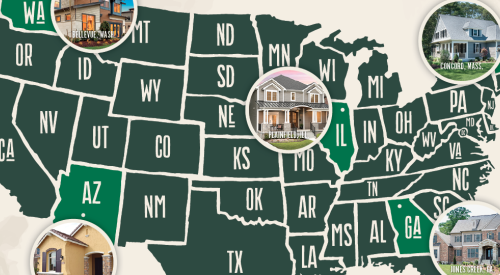Let's just call this Part II of our 2003 report on housing's Giants because we found one we missed before our April issue closed. In fact, we've missed elusive, Pittsburgh-based Maronda Homes every year for a long time. This stealth Giant has been flying under the industry radar, and it's no accident. The company wants to be invisible.
"Maronda is very secretive," says Jeff Bird, president of Pittsburgh Construction News. "Bill Wolf is a very private guy, and he wants the world to know as little as possible about his company and how it operates."
Founded in 1972 by CEO William J. Wolf and run today by president Ronald Wolf, Maronda specializes in entry-level and first move-up single-family detached homes, although it does build some attached product. It builds in three states (Pennsylvania, Ohio and Florida), primarily in six metropolitan markets (Pittsburgh; Columbus, Ohio; and Orlando, Tampa, Jacksonville and Melbourne, Fla.).
The firm's Web site, www.maronda.com, lays claim to the motto "An Easily Observable Better Value." This is virtually the same niche pioneered by Ryan Homes, the original Pittsburgh-based production building dynamo, after World War II. Ryan happens to be where William J. Wolf cut his teeth as a housing executive. The Web site reveals that Maronda will not let customers make changes to any house plan and will not co-broker sales with Realtors.
The Web site also claims that Maronda has built more than 20,000 homes, so it's obvious this firm builds a lot of housing every year, even if the company owners wish that no one, other than their customers, would notice.
How can we explain not noticing the 38th-largest home building company in America, a firm we now estimate had 3,594 closings in 2002 for revenue of $478.02 million? That's a question we certainly ask ourselves. Part of the answer is that Maronda is hiding. Most of America's largest builders are eager to fill out our questionnaires, get into our database and be part of the industry's definitive tally sheet every year. Not Maronda. When we found our oversight in not ranking the firm, we telephoned - repeatedly. No call was answered. Moreover, when we called employees in out-of-town divisions, those calls also went unanswered, unacknowledged and unreturned.
Why?
| Approximately what percentage of your planned developments/communities include broadband access?
|
Benefits of Being Ranked
Inclusion in the Giant 400 certainly carries benefits. Perhaps most important, builders tell us that financing gets easier to come by the higher they rank. Municipalities also are easier to deal with if they see that a company has the staying power to rank as a Giant every year. And many builders say they view moving up in the rankings as a public pat on the back for their employees.
However, each year a number of companies balk at submitting their data for a variety of reasons - the most common, that revenue went down and company officers don't want to see that number in print. When that happens, we call and politely explain that inclusion in the Giant 400 is not voluntary. If a company exists and has residential closings, our pledge to readers is to find the data and rank the company on estimated closings and revenue.
When forced to do that, whenever possible we use public data on building permits as the basis for the estimate. In most metro housing markets, at least one company specializes in publishing housing data obtained by accessing public records of residential permits.
For example, Bird reported to us that Maronda pulled 391 building permits in the Pittsburgh market in 2002. At an average price of $200,000 for detached homes and $150,000 for attached product, that gives us a revenue estimate of $75.3 million in that market.
In Columbus, Kenneth Danter Co. reported that Maronda pulled 345 residential building permits in 2002 and that the average price of those homes was $151,671. That's how we estimated the firm's dollar volume in Columbus at $52.33 million. Maronda's output in both its northern markets essentially was flat over the previous year. Florida is another story.
Maronda seems to be growing by leaps and bounds in Florida. Our estimates, based on building permit data, are that the firm closed 1,300 sales in Orlando in 2002, at an average price of $127,000, for $165.1 million in revenue. In Tampa, permit data leads us to estimate that Maronda closed 500 sales for $60.33 million. In Jacksonville, our estimate is 500 closings for $58 million. And in Melbourne and the Brevard County market stretching along Florida's east coast, we estimate Maronda built 558 houses for $66.96 million. Obviously, Maronda has nothing to be ashamed of in terms of production and growth.
How confident are we of the accuracy of our estimates on Maronda? We are certain that actual numbers are not lower, but they could be higher. We probably err on the low side because Maronda might have scattered lot operations outside the municipalities and counties where we pulled building permit data.
Maronda's Secret
We believe Maronda's reticence to be thrust into the limelight stems from its unique operating model, which in-cludes major intrusions into the supply chain. The firm's Web site touches on that, stating that Maronda "supplies most of the materials and produces many of the components" that go into its homes.
The firm has a major distribution center in Sanford, Fla., that ships materials and products to job sites all over northern and central Florida. Builders who compete with Maronda in Florida and Ohio say the firm sells at a price per square foot they cannot match, even when their land costs are the same or lower.
"They want to be their own supplier," one Orlando-area competitor says, "but they are very secretive about it."
Another Florida competitor says, "They try to supply all the materials and labor to the job site at the absolute lowest cost by standardizing their plans and panelizing or fabricating as much as possible from their own manufacturing facilities. They are buying and warehousing air conditioning, plumbing and electrical products, cabinets and even doorjambs."
An Ohio competitor says, "They seem to be panelizing a lot. I've seen them use a new kind of panelized floor deck that I've never seen anyone else use. They bring the whole thing out in two or three pieces and drop it on the foundation. They seem to drive every cent they possibly can out of hard costs."
Another Florida builder who says he goes head-to-head with Maronda and has the same land costs contends that the firm works off very thin margins. "They are selling a 2,000-square-foot house for $90,000," he says. "My 1,400-square-foot house is the same price. When I back into their numbers, I find them working off gross margins of 5% to 7%. I can't get to their prices."
It seems likely to us that the Wolf family believes they have found the secret to delivering an easily observable better value and that the best way to keep that secret is to repel radar.












